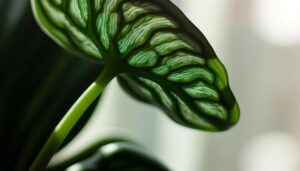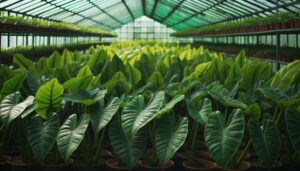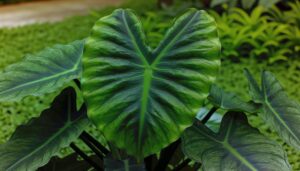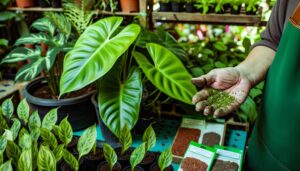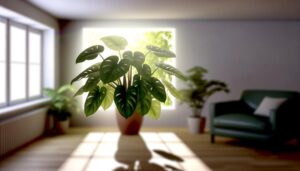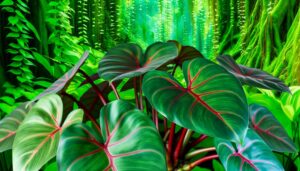What Is Philodendron Hope S?
Philodendron Hope Selloum, scientifically known as *Philodendron bipinnatifidum*, is a robust tropical plant from the Araceae family. Indigenous to South America, it features large, glossy, deeply lobed leaves and a robust stem structure.
This plant thrives in well-draining, organic-rich soil with consistent watering, moderate to high light, and temperatures ranging from 65-78°F (18-26°C). It benefits from humidity levels above 60%.
Prone to pests like spider mites and mealybugs, it requires regular maintenance and occasional pruning. For those interested in its propagation techniques or want to learn about its ornamental value, further details await.
Key Takeaways
- Philodendron Hope Selloum is a tropical plant native to South America, especially Brazil, Argentina, Bolivia, and Paraguay.
- It features large, deeply lobed, glossy dark green leaves that can grow up to 60 cm long.
- The plant thrives in moderate to high light intensity but should avoid direct sunlight to prevent leaf scorching.
- It prefers well-draining soil rich in organic matter and requires consistent, moderate watering.
- Common pests include spider mites and mealybugs, and it is susceptible to diseases like root rot and bacterial leaf spot.
Origin and Background
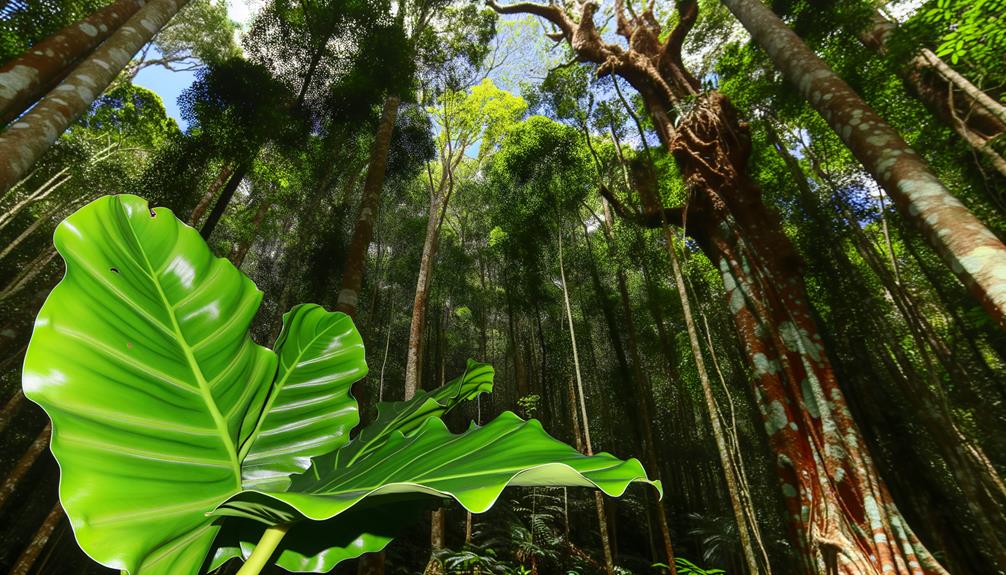
The Philodendron Hope Selloum, also known scientifically as Philodendron bipinnatifidum, originates from the tropical regions of South America, particularly in countries such as Brazil, Argentina, Bolivia, and Paraguay.
This plant thrives in humid, subtropical climates where it benefits from the rich, well-drained soils typical of its native habitats. It belongs to the Araceae family, which encompasses a wide variety of aroid species known for their robust foliage and adaptability.
Historically, Philodendron bipinnatifidum has been utilized by indigenous populations for its ornamental and potential medicinal properties. Its resilience and ability to adapt to various environmental conditions have made it a popular choice for cultivation in both indoor and outdoor settings, particularly in regions that can mimic its native tropical environment.
Physical Characteristics
Philodendron Hope S exhibits distinct physical characteristics. These include large, deeply lobed leaves, scientifically termed as pinnatifid leaves, which can reach up to 60 cm in length.
The stem structure is robust and thick, often featuring prominent aerial roots that enhance nutrient absorption and stability.
The foliage presents a vibrant green coloration with a glossy texture, indicative of its healthy chlorophyll content and efficient photosynthetic capability.
Leaf Shape and Size
Characterized by large, deeply lobed leaves, Philodendron bipinnatifidum exhibits a unique morphology that facilitates efficient light capture and gas exchange.
The leaves, which can reach up to 3 feet in length and 2 feet in width, are pinnately compound with multiple lobes, enhancing their surface area. This increased surface area is crucial for maximizing photosynthetic efficiency.
The glossy, dark green foliage is supported by robust petioles, providing both structural integrity and flexibility. Each lobe is intricately veined, contributing to effective nutrient transport and mechanical support.
The sinus, or the space between lobes, allows for improved airflow and reduced transpiration rates. This adaptation is particularly advantageous in its native tropical environments, optimizing both light absorption and gas exchange.
Stem and Root Structure
Complementing its distinctive foliar architecture, Philodendron bipinnatifidum exhibits a robust stem structure characterized by thick, woody stems that provide mechanical support and facilitate nutrient transport.
The stems are lignified, ensuring rigidity and resilience against physical stress. Internodes are typically short, contributing to the plant's compact growth habit.
Adventitious roots emerge along these stems, enhancing stability and nutrient uptake. The root system is extensive, comprising both aerial and subterranean roots.
Aerial roots are particularly remarkable for their role in moisture absorption and anchorage. Subterranean roots exhibit fine root hairs that maximize surface area for best water and nutrient absorption.
Collectively, the stem and root structures of Philodendron bipinnatifidum are integral to its adaptability and vigor in diverse environmental conditions.
Color and Texture
The foliage of Philodendron bipinnatifidum exhibits a vibrant green hue, with mature leaves developing a glossy texture that enhances their visual appeal and functional durability. This species' leaves, scientifically termed as laminae, are deeply lobed and can grow up to three feet in length, contributing to its majestic presence.
The leaf surface is smooth and slightly leathery, providing a resilient structure against environmental stressors.
- Color: Vivid green, intensifying with maturity.
- Texture: Glossy and smooth, with a slight leathery feel.
- Shape: Deeply lobed, pinnatifid structure.
- Size: Laminae can reach lengths of up to three feet.
These characteristics collectively make Philodendron bipinnatifidum an aesthetically pleasing and robust addition to any collection.
Ideal Growing Conditions
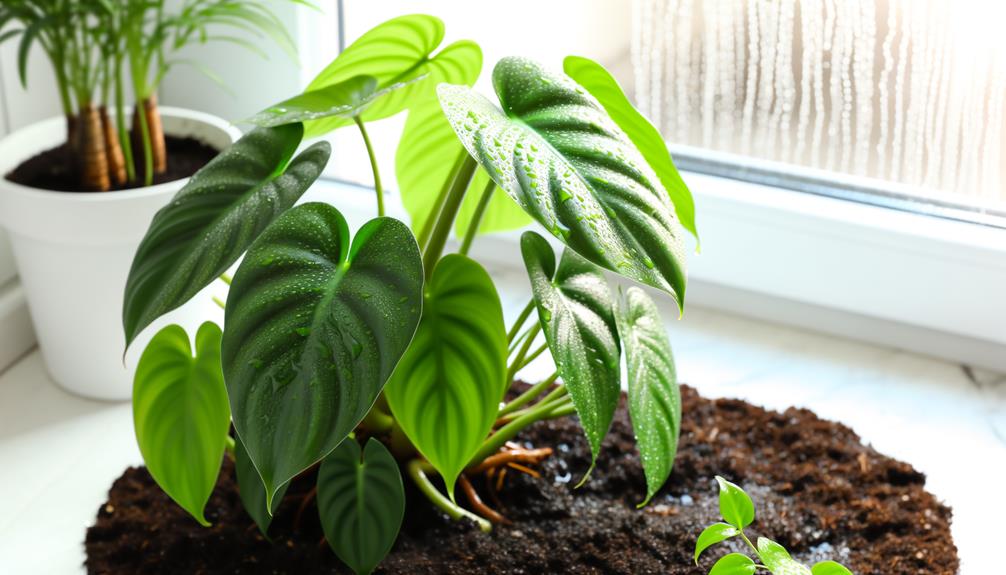
Philodendron bipinnatifidum 'Hope' thrives under specific environmental conditions that promote ideal growth. It requires indirect, bright light to stimulate photosynthesis while preventing leaf burn, and well-draining, nutrient-rich soil to sustain proper moisture levels without waterlogging.
Additionally, maintaining temperatures between 18-27°C (65-80°F) and high humidity levels is essential for its physiological processes and overall health.
Light Requirements
Ideal light conditions for *Philodendron bipinnatifidum* involve bright, indirect sunlight, which promotes vigorous growth and prevents leaf scorching. This species thrives under filtered light, mimicking its natural, understory habitat in tropical forests.
Direct exposure to intense sunlight can cause photodamage, leading to chlorosis and leaf burn. Conversely, insufficient light can result in etiolation, characterized by elongated stems and pale foliage.
- Light Intensity: Moderate to high, with avoidance of direct sun rays.
- Duration: Approximately 10-12 hours of light per day.
- Light Source: Natural sunlight filtered through sheer curtains or artificial grow lights.
- Placement: Position near east or north-facing windows for optimal light exposure.
Following these guidelines promotes robust foliage and overall plant health.
Soil and Watering
Ensuring ideal growth for *Philodendron bipinnatifidum* necessitates a well-draining soil mix rich in organic matter and consistent, moderate watering practices. A suitable substrate typically includes a blend of peat moss, perlite, and pine bark, offering essential aeration and moisture retention.
This species thrives in soil that remains evenly moist but not waterlogged, as excessive water can lead to root rot. It is advisable to allow the top inch of soil to dry out between waterings. Employing a pot with drainage holes is critical to prevent water accumulation. Regularly checking soil moisture using a moisture meter can optimize hydration levels.
Proper soil and watering practices are fundamental to promoting robust growth and overall plant health for *Philodendron bipinnatifidum*.
Temperature and Humidity
Maintaining ideal temperature and humidity levels is crucial for the healthy development of *Philodendron bipinnatifidum*, as it prefers temperatures ranging between 65-78°F (18-26°C) and humidity levels above 60%. Best conditions guarantee the plant's physiological processes, such as transpiration and photosynthesis, function efficiently. It's critical to avoid sudden temperature fluctuations or prolonged exposure to temperatures below 55°F (13°C), which can stress the plant.
Key considerations:
- Humidity: Maintain levels above 60% to prevent leaf desiccation.
- Temperature: Keep within the 65-78°F (18-26°C) range for optimal growth.
- Air Circulation: Ensure good airflow to reduce fungal infections.
- Monitoring: Use a hygrometer and thermometer for precise control.
Such measures promote vigorous growth and overall plant health.
Watering Requirements
Philodendron bipinnatifidum, commonly known as Philodendron Hope S, requires consistent moisture levels in its soil to thrive best. It is essential to maintain a balance where the soil remains evenly moist but not waterlogged, which can lead to root rot.
| Watering Frequency | Moisture Level |
|---|---|
| Weekly | Evenly moist |
| Bi-weekly | Slightly dry |
| Overwatering | Soggy soil |
| Underwatering | Dry soil |
During the growing season, typically spring and summer, watering frequency may increase due to higher metabolic activity. Conversely, in the dormant period of fall and winter, watering should be reduced. Utilizing well-draining pots can prevent excessive moisture retention, ensuring the roots remain healthy and aerated.
Soil and Potting
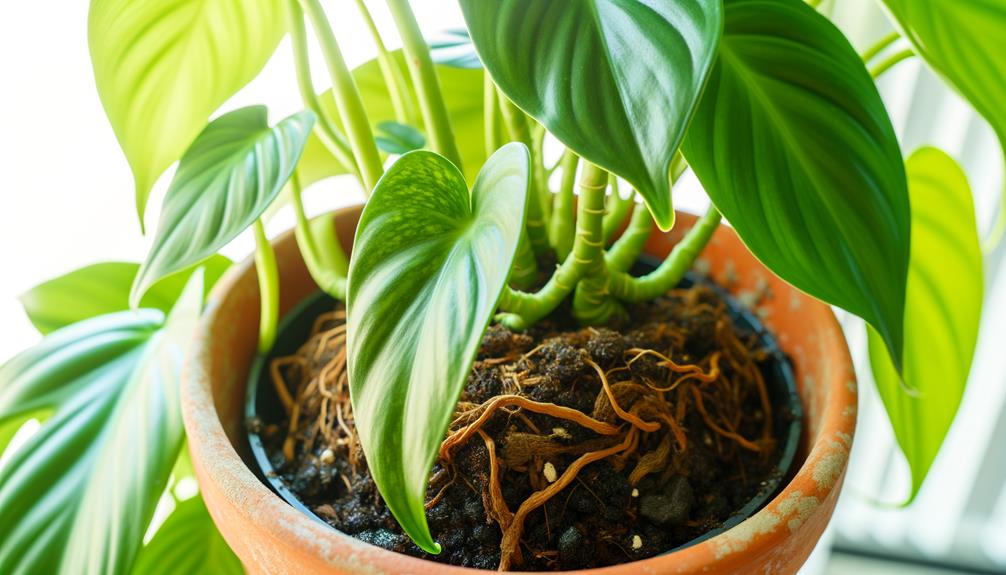
To enhance the growth of Philodendron bipinnatifidum, a well-aerated, nutrient-rich potting mix is essential. The substrate should promote proper drainage while retaining sufficient moisture. An ideal potting medium typically includes components that improve aeration and nutrient retention.
- Peat Moss: Provides moisture retention and a slightly acidic pH.
- Perlite: Enhances drainage and prevents soil compaction.
- Pine Bark: Increases aeration and mimics the plant's natural epiphytic growing conditions.
- Compost: Supplies organic nutrients and improves soil structure.
Ensuring a balanced mixture not only promotes root health but also supports vigorous growth. The pot should have adequate drainage holes to prevent waterlogging, which can lead to root rot.
Regular monitoring and adjusting of the soil composition are essential for optimal plant health.
Light Preferences
Philodendron bipinnatifidum, commonly known as Philodendron Hope S, thrives in environments with bright, indirect sunlight, which promotes best photosynthetic activity while preventing leaf scorch.
This species exhibits a broad tolerance for varying light levels, adapting to both lower light conditions and filtered sunlight.
Ensuring appropriate light exposure is important for maintaining the plant's physiological health and robust growth.
Indirect Sunlight Benefits
Maximizing the advantages of indirect sunlight is vital for the optimal growth of Thaumatophyllum bipinnatifidum. Excessive direct light can lead to photoinhibition and leaf burn. Indirect sunlight promotes ideal photosynthesis without the harmful effects of intense light exposure. This practice not only promotes strong growth but also preserves the plant's lush, green foliage.
Advantages of indirect sunlight for Thaumatophyllum bipinnatifidum include:
- Improved chlorophyll production: Facilitates effective light capture for photosynthesis.
- Reduced risk of photoinhibition: Prevents damage to photosystem II.
- Regulated leaf temperature: Prevents overheating and desiccation.
- Decreased leaf burn risk: Preserves the integrity of the epidermal layer.
Understanding these benefits is important for maintaining the health and visual attractiveness of Philodendron Hope S.
Light Level Tolerance
Thaumatophyllum bipinnatifidum exhibits a remarkable range of light tolerance, thriving best in environments with bright, indirect light while also demonstrating adaptability to lower light conditions. This species shows best growth when placed in filtered light, where direct sunlight is diffused, reducing the risk of leaf burn. In suboptimal lighting, such as shaded interiors, the plant maintains its vitality, though growth rates may slow. Understanding the nuanced light preferences of Thaumatophyllum bipinnatifidum is essential for ensuring its health and vigor.
| Light Level | Growth Rate | Leaf Health |
|---|---|---|
| Bright, Indirect | Optimum | Vibrant, Healthy |
| Moderate, Indirect | Moderate | Slightly Slower |
| Low Light | Minimal | Reduced, Pale |
Common Pests and Diseases
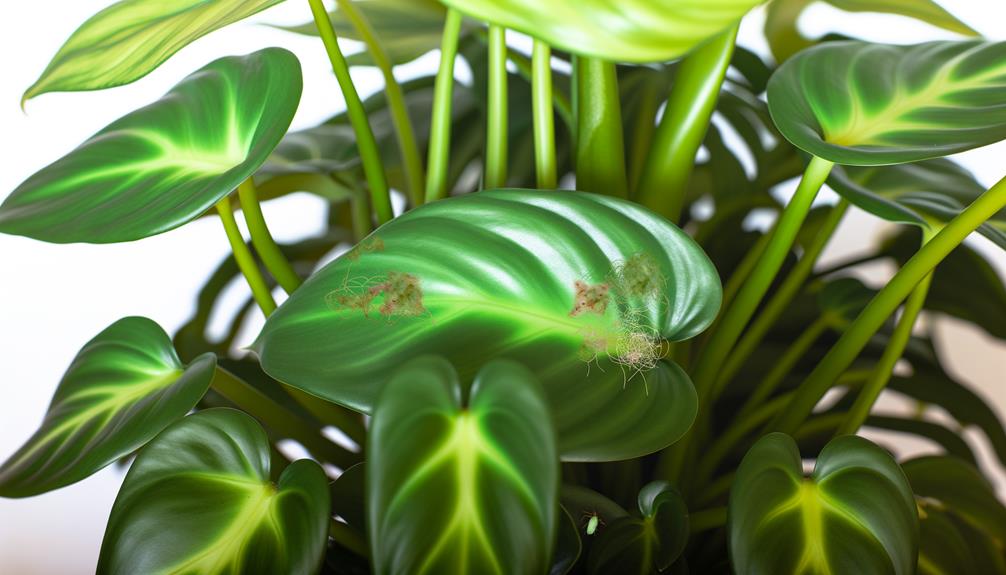
Understanding the common pests and diseases affecting Philodendron bipinnatifidum, such as spider mites (Tetranychidae) and bacterial leaf spot (Xanthomonas campestris), is crucial for effective plant care and management. These issues can severely impact plant health if not addressed promptly. Effective identification and treatment are paramount to maintaining the vigor of Philodendron Hope S.
- Spider Mites (Tetranychidae): These tiny arachnids cause stippling, leaf discoloration, and webbing.
- Mealybugs (Pseudococcidae): These pests appear as white, cotton-like masses, leading to sooty mold and stunted growth.
- Bacterial Leaf Spot (Xanthomonas campestris): Characterized by water-soaked lesions, turning black and causing leaf drop.
- Root Rot (Pythium spp.): Results from overwatering and manifests as black, mushy roots, ultimately leading to plant decline.
Addressing these issues promptly guarantees the health and longevity of the plant.
Pruning and Maintenance
Regular trimming of *Philodendron bipinnatifidum* is crucial to maintain its shape, encourage healthy growth, and prevent the spread of diseases.
Utilizing sterilized trimming shears, remove yellowing or dead leaves at the base to improve the plant's appearance and strength.
Additionally, thinning out overcrowded stems guarantees sufficient air circulation, reducing the risk of fungal infections.
Trimming should be done during the active growth period, typically in spring and summer. Avoid cutting more than one-third of the plant at a time to minimize stress.
Regularly check for any signs of pests or diseases, and promptly eliminate affected areas. Dispose of all trimmed material properly to prevent contamination.
Appropriate maintenance promotes a strong and visually appealing *Philodendron bipinnatifidum*.
Propagation Techniques
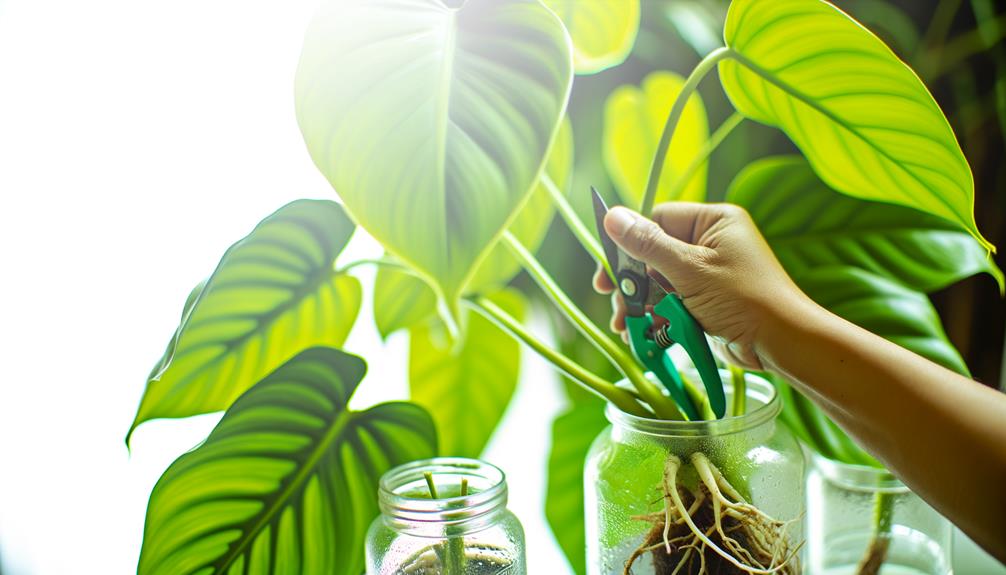
Beyond routine maintenance, effective propagation techniques are crucial to expanding your collection of *Philodendron bipinnatifidum*. Propagation can be achieved through various methods, each necessitating careful attention to environmental conditions and plant health.
- Stem Cuttings: Select a healthy stem section with at least one node. Use sterilized tools to prevent disease transmission.
- Air Layering: Create a small wound on a healthy stem, apply rooting hormone, and wrap with moist sphagnum moss and plastic wrap.
- Division: Carefully separate the root ball into smaller sections, making sure each division has sufficient roots and foliage.
- Seed Propagation: Although less common, germinate seeds in a controlled environment with consistent moisture and temperature.
Proper execution of these techniques guarantees robust and thriving *Philodendron bipinnatifidum* specimens.
Benefits of Philodendron Hope S
The *Philodendron bipinnatifidum*, commonly known as Philodendron Hope S, offers numerous benefits, including air purification, aesthetic enhancement, and low maintenance requirements.
Its broad, deeply lobed leaves are effective in removing volatile organic compounds (VOCs) such as formaldehyde from indoor environments, contributing to improved air quality.
Aesthetically, the lush, green foliage adds a tropical ambiance, making it an exemplary choice for interior landscaping.
Additionally, Philodendron Hope S is well-suited for both residential and commercial settings due to its low maintenance needs. It thrives in indirect light and requires minimal watering, making it an ideal plant for individuals with busy lifestyles.
This species' resilience and adaptability further underscore its suitability for a variety of indoor conditions.
Conclusion
Philodendron bipinnatifidum, commonly known as Philodendron Hope S, is an adaptable, low-maintenance plant, ideal for indoor environments. With robust foliage and air-purifying capabilities, it enhances both aesthetic and health aspects of living spaces.
An intriguing statistic is that indoor plants, such as Philodendron Hope S, can reduce indoor air pollutants by up to 87% within 24 hours, according to a NASA clean air study. This underscores the plant's dual function as both an ornamental and a functional element in interior design.

